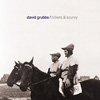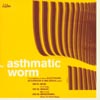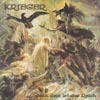 This compilation brings together several early and now hard-to-findsingles by Britain's prolific ISAN, comprised of Robin Saville andAntony Ryan. The tracks, which come primarily from 7"s dating from 1997to 1999 on labels like Wurlitzer Jukebox, Earworm and Bad Jazz, breathenew life into a genre which, especially as of late, has begun toflounder with acts that are virtually indistinguishable. "Autolung" isan exhibition of their hypnotic, haunting signature sound: ISAN's brandof electronic music is introspective without over-intellectualization,and is often childlike, but never infantile, particularly with regardsto the choice of vocal samples they sometimes use. "Damil 85", whichmakes use of such a sample, is brilliant, and quite possibly one of thebest tracks the duo has ever done. "Remegio" is full of a chilling andmelancholy beauty. Understated yet often playful beats ebb and flowseamlessly and consistently throughout every piece. Another gem fromfrom the lovely Morr Music.
This compilation brings together several early and now hard-to-findsingles by Britain's prolific ISAN, comprised of Robin Saville andAntony Ryan. The tracks, which come primarily from 7"s dating from 1997to 1999 on labels like Wurlitzer Jukebox, Earworm and Bad Jazz, breathenew life into a genre which, especially as of late, has begun toflounder with acts that are virtually indistinguishable. "Autolung" isan exhibition of their hypnotic, haunting signature sound: ISAN's brandof electronic music is introspective without over-intellectualization,and is often childlike, but never infantile, particularly with regardsto the choice of vocal samples they sometimes use. "Damil 85", whichmakes use of such a sample, is brilliant, and quite possibly one of thebest tracks the duo has ever done. "Remegio" is full of a chilling andmelancholy beauty. Understated yet often playful beats ebb and flowseamlessly and consistently throughout every piece. Another gem fromfrom the lovely Morr Music.
samples:



 Fennesz 'Endless Summer' was the big across board hit of last year,obviously much more interesting in it's original invention thanRadiohead's thinly veiled Elton John impressions or Bjork's vaudevillesugar puff powderings. 'Endless Summer' appealed to blandpiggys andnoizheds alike and it was quite interesting to see the diverse music itrubbed shoulders with in all those yearend bestlisten lists. Fenneszstays visible with ever more recordings of varied live encounters, andalthough I haven't yet heard his Mika Vainio collaboration that got aslating from Nate Smith a couple of months back, I've always foundthat, like Otomo Yoshihide, for Fennesz quantity does not negatequality. This three way improvisation, recorded late in 2000, takes aclassic improvisation approach, in as much as AMM could be consideredclassic, but these artists are daubing from a very distinctive noisepallet. There are some very obvious similarities to AMM in the way theyslowly build up morphing dense layers from almost nothing, sewing inoccasional hacked fragments of radiopops. Fennesz might have started itwith a sampled fractious descending piano run, but then again itcould've been Gert-Jan Prins' kick off, or perhaps Van Bergen wasactually playing a piano? The haunting beauty unfolds fromradiocaptures and junk contraptions complimenting the familiar Fenneszgentle guitarshift distortion textures for Peter Van Bergen'sunderstated but understanding saxophone to unwind around, blurtingcamouflaged in strange new ruptured lung distortion fractions. Aquarter hour in he fires off some almost classic free jazz moves thatquickly get torn apart by effects and spat back into the whirling void,all mangled and digidiminished. Whilst the prospect of having to switchthe blip-attention spans on to a single forty two minute track mightput off some blandpiggys, and noizheads might make gripewater out ofthe ever dipping levels and relatively reflective yet murky pools hereand there, this is definitely more than just a worthy and curiousaddition to the ever expanding Fennesz ouevre. The crescendo at aroundthe half hour point is top notch liberating primal freenoise, piling upvariegated deep drones to breaking point. They drop down again to letpiano patter and metal chimes ring over the digisplutter and zoom focuslens splatter squeals but it builds again to a warped summer ending.These noisemakers play it organic, so that it becomes difficult toseparate any individual chaos panic. They also bring an intuitiveunderstanding of electro-acoustic sudden shock echoblam to theirconstantly mutating crunchy evolution. 'Dawn' makes me curious to hearmore from Van Bergen and especially Prins, whose noise patchwork freeskronking with Lee Ranaldo made for a surprising Radio 3 highlight acouple of years back, a recording which was made on a night when I wasacross London town listening to Wire. Sometimes it seems there's somuch happening you just need to split yourself in two to experience itall, which makes me glad that Fennesz makes these recordings of livesituations. When the sun rises, I will listen.
Fennesz 'Endless Summer' was the big across board hit of last year,obviously much more interesting in it's original invention thanRadiohead's thinly veiled Elton John impressions or Bjork's vaudevillesugar puff powderings. 'Endless Summer' appealed to blandpiggys andnoizheds alike and it was quite interesting to see the diverse music itrubbed shoulders with in all those yearend bestlisten lists. Fenneszstays visible with ever more recordings of varied live encounters, andalthough I haven't yet heard his Mika Vainio collaboration that got aslating from Nate Smith a couple of months back, I've always foundthat, like Otomo Yoshihide, for Fennesz quantity does not negatequality. This three way improvisation, recorded late in 2000, takes aclassic improvisation approach, in as much as AMM could be consideredclassic, but these artists are daubing from a very distinctive noisepallet. There are some very obvious similarities to AMM in the way theyslowly build up morphing dense layers from almost nothing, sewing inoccasional hacked fragments of radiopops. Fennesz might have started itwith a sampled fractious descending piano run, but then again itcould've been Gert-Jan Prins' kick off, or perhaps Van Bergen wasactually playing a piano? The haunting beauty unfolds fromradiocaptures and junk contraptions complimenting the familiar Fenneszgentle guitarshift distortion textures for Peter Van Bergen'sunderstated but understanding saxophone to unwind around, blurtingcamouflaged in strange new ruptured lung distortion fractions. Aquarter hour in he fires off some almost classic free jazz moves thatquickly get torn apart by effects and spat back into the whirling void,all mangled and digidiminished. Whilst the prospect of having to switchthe blip-attention spans on to a single forty two minute track mightput off some blandpiggys, and noizheads might make gripewater out ofthe ever dipping levels and relatively reflective yet murky pools hereand there, this is definitely more than just a worthy and curiousaddition to the ever expanding Fennesz ouevre. The crescendo at aroundthe half hour point is top notch liberating primal freenoise, piling upvariegated deep drones to breaking point. They drop down again to letpiano patter and metal chimes ring over the digisplutter and zoom focuslens splatter squeals but it builds again to a warped summer ending.These noisemakers play it organic, so that it becomes difficult toseparate any individual chaos panic. They also bring an intuitiveunderstanding of electro-acoustic sudden shock echoblam to theirconstantly mutating crunchy evolution. 'Dawn' makes me curious to hearmore from Van Bergen and especially Prins, whose noise patchwork freeskronking with Lee Ranaldo made for a surprising Radio 3 highlight acouple of years back, a recording which was made on a night when I wasacross London town listening to Wire. Sometimes it seems there's somuch happening you just need to split yourself in two to experience itall, which makes me glad that Fennesz makes these recordings of livesituations. When the sun rises, I will listen. I think there comes a time (or rather, a number of times) when a musicenthusiast/record collector finally becomes hooked on something theynever really paid much attention to for years and just think over andover again, "damn, what was I thinking?" This holds true for me andChristoph Heemann's work and the music contained herein is noexception. Originally released as a limited edition in 1997, the musicon this disc accompanies four short stories by Thomas Ligotti writtenfor David Tibet. The musical accompaniment by Christoph Heemann andSteven Stapleton is intense enough to stand on its own yet subtleenough to be read along to as recommended in the booklet. Low, rumblingdrones underscore fleeting sound effects and garbled voices throughoutthe opener, "His Shadow Will Rise to a Higher House" and a tuba melody"A Soft Voice Whispers Nothing," while echoed and layered bells ringout during the haunting "The Bells Will Sound Forever." Only rarelywill a voice pop in from Tibet, Andria Degens (Pantaleimon) or ShirleyCollins, narrating small portions of the text, essentially performingthe role as suggestive guidelines as to where the story should be. Thevoices aren't overbearing but I'm really in mixed worlds whether tothink the narration should run throughout or the music should becompletely instrumental. The stories by Ligotti are rather entertainingand a light read, but my lack of ability to respectfully critiquefiction can't go much deeper into them than that. All the text andartwork has been reprinted from the first edition, however, thisversion is unfortunately in a rather chinchy digipack when compared tothe hardcover original. Regardless, the music is essential for anyfanatic Mirror fan and could easily make a Heemann fan out of anyexisting C93 fan.
I think there comes a time (or rather, a number of times) when a musicenthusiast/record collector finally becomes hooked on something theynever really paid much attention to for years and just think over andover again, "damn, what was I thinking?" This holds true for me andChristoph Heemann's work and the music contained herein is noexception. Originally released as a limited edition in 1997, the musicon this disc accompanies four short stories by Thomas Ligotti writtenfor David Tibet. The musical accompaniment by Christoph Heemann andSteven Stapleton is intense enough to stand on its own yet subtleenough to be read along to as recommended in the booklet. Low, rumblingdrones underscore fleeting sound effects and garbled voices throughoutthe opener, "His Shadow Will Rise to a Higher House" and a tuba melody"A Soft Voice Whispers Nothing," while echoed and layered bells ringout during the haunting "The Bells Will Sound Forever." Only rarelywill a voice pop in from Tibet, Andria Degens (Pantaleimon) or ShirleyCollins, narrating small portions of the text, essentially performingthe role as suggestive guidelines as to where the story should be. Thevoices aren't overbearing but I'm really in mixed worlds whether tothink the narration should run throughout or the music should becompletely instrumental. The stories by Ligotti are rather entertainingand a light read, but my lack of ability to respectfully critiquefiction can't go much deeper into them than that. All the text andartwork has been reprinted from the first edition, however, thisversion is unfortunately in a rather chinchy digipack when compared tothe hardcover original. Regardless, the music is essential for anyfanatic Mirror fan and could easily make a Heemann fan out of anyexisting C93 fan. Gastr del Sol, with their complicated arrangements, electronic interludes, and guitar work drawn from obscure North American folk and rock influences, would have been more than qualified to take a marketable place amongst the identikit post-rock outfits doing the rounds in the mid-nineties. But instead of achieving Tortoise-proportioned recognition, they remained a relative obscurity, and perhaps part of the reason for that was David Grubbs's unique vocal and lyrical contribution.
Gastr del Sol, with their complicated arrangements, electronic interludes, and guitar work drawn from obscure North American folk and rock influences, would have been more than qualified to take a marketable place amongst the identikit post-rock outfits doing the rounds in the mid-nineties. But instead of achieving Tortoise-proportioned recognition, they remained a relative obscurity, and perhaps part of the reason for that was David Grubbs's unique vocal and lyrical contribution. "The name IAO is Kabbalistically identical to the Beast and his numberis 666." John Zorn's new album consists of a seven-movement suite thatbrings his obsessions with Alchemy, Metaphysics and the work of KennethAnger to the fore. Continuing Zorn and Tzadik's tradition of excellentpackaging, the CD is accompanied by a series of postcard-styledinserts, each bearing Kabbalistic signs, arcane scribblings and creditsprinted in a lovely but nearly undecipherable typeface. Musically,"IAO" is a consolidation of Zorn's recent artistic developments: thecomplex writing of "Madness, Love and Mysticism", the electronicexperimentation of "Songs from the Hermetic Theatre" and thefascination with easy listening/exotica explored on "The Gift" havebeen beautifully integrated into his syncretic style. The firstmovement, "Invocation," sets a strange scene: a knife is sharpened andwater or blood is splashed about as someone chants off in the distanceand Jamie Saft plays spooky organ. "Sex Magick" is more of CyroBaptista's astounding trance drumming, such as was heard on "Taboo andExile". The mesmeric, time-obliterating property of the piece isremarkable and it would, indeed, be a perfect compliment to the titularactivity. "Sacred Rites of the Left Hand Path," the third movement,combines Saft's jazzily syncopated piano with electronic sounds in atune filled with both whimsy and threat. "The Clavicle of Solomon" isthe deeply weird piece that follows, made up of high-frequency digitaltones and creepy microtonal melodies. The erotic resurfaces in thefifth movement, "Lucifer Rising," for female chorus. It is led by theincredibly sexy-voiced Jennifer Charles (of the wonderful group ElysianFields), who vacillates between menacing, incantatory and ecstatic asshe moans, groans, shudders and whispers through the piece. The aptlytitled "Leviathan" follows, a death metal monstrosity that collapses inon itself under the enormous weight of Bill Laswell's thunderous bass,becoming a howling vortex of noise sucking up backwards cymbals andMike Patton as he shreds his larynx. "IAO" then settles into the finalmovement, the dark and peaceful "Mysteries", which has a feeling ofresolution about it. As a whole, this record succeeds brilliantly. Itis, like all the best albums, its own sound-world to be explored, aworld of great mystery and wonder. Part of its genius is in itsconstruction. While Zorn never restates a theme, he consistentlyreturns to specific moods. In "IAO" the form is forgotten and thefeelings become the form.
"The name IAO is Kabbalistically identical to the Beast and his numberis 666." John Zorn's new album consists of a seven-movement suite thatbrings his obsessions with Alchemy, Metaphysics and the work of KennethAnger to the fore. Continuing Zorn and Tzadik's tradition of excellentpackaging, the CD is accompanied by a series of postcard-styledinserts, each bearing Kabbalistic signs, arcane scribblings and creditsprinted in a lovely but nearly undecipherable typeface. Musically,"IAO" is a consolidation of Zorn's recent artistic developments: thecomplex writing of "Madness, Love and Mysticism", the electronicexperimentation of "Songs from the Hermetic Theatre" and thefascination with easy listening/exotica explored on "The Gift" havebeen beautifully integrated into his syncretic style. The firstmovement, "Invocation," sets a strange scene: a knife is sharpened andwater or blood is splashed about as someone chants off in the distanceand Jamie Saft plays spooky organ. "Sex Magick" is more of CyroBaptista's astounding trance drumming, such as was heard on "Taboo andExile". The mesmeric, time-obliterating property of the piece isremarkable and it would, indeed, be a perfect compliment to the titularactivity. "Sacred Rites of the Left Hand Path," the third movement,combines Saft's jazzily syncopated piano with electronic sounds in atune filled with both whimsy and threat. "The Clavicle of Solomon" isthe deeply weird piece that follows, made up of high-frequency digitaltones and creepy microtonal melodies. The erotic resurfaces in thefifth movement, "Lucifer Rising," for female chorus. It is led by theincredibly sexy-voiced Jennifer Charles (of the wonderful group ElysianFields), who vacillates between menacing, incantatory and ecstatic asshe moans, groans, shudders and whispers through the piece. The aptlytitled "Leviathan" follows, a death metal monstrosity that collapses inon itself under the enormous weight of Bill Laswell's thunderous bass,becoming a howling vortex of noise sucking up backwards cymbals andMike Patton as he shreds his larynx. "IAO" then settles into the finalmovement, the dark and peaceful "Mysteries", which has a feeling ofresolution about it. As a whole, this record succeeds brilliantly. Itis, like all the best albums, its own sound-world to be explored, aworld of great mystery and wonder. Part of its genius is in itsconstruction. While Zorn never restates a theme, he consistentlyreturns to specific moods. In "IAO" the form is forgotten and thefeelings become the form. This is what happens when you grab a handful of Icelandic musicians andlock them in a cabin for a couple weekends by the fire until they'verecorded an album. For something as ad hoc, it remarkably sounds like aband who's shared a number of years and a number of beers, and for agroup which includes members of electro super-nerds Trabant (andreleased on the label that issued them and Múm), it's entirely organic,with a lazy, almost clumsy drive not entirely unlike Molasses or WillOldham records without the whininess. With one female and two malevocalists, the subjects covered are nothing deep at all, includinggirls, drinking, pimple-faced teenagers, mothers and the weather.Perhaps obsessed with a number of Louisville bands who made it out orromanticizing about playing in a cheap western bar where fat rednecksonly drink cheap beer from a can, the Funerals make me wonder why morebands don't play the truckstop circuit.
This is what happens when you grab a handful of Icelandic musicians andlock them in a cabin for a couple weekends by the fire until they'verecorded an album. For something as ad hoc, it remarkably sounds like aband who's shared a number of years and a number of beers, and for agroup which includes members of electro super-nerds Trabant (andreleased on the label that issued them and Múm), it's entirely organic,with a lazy, almost clumsy drive not entirely unlike Molasses or WillOldham records without the whininess. With one female and two malevocalists, the subjects covered are nothing deep at all, includinggirls, drinking, pimple-faced teenagers, mothers and the weather.Perhaps obsessed with a number of Louisville bands who made it out orromanticizing about playing in a cheap western bar where fat rednecksonly drink cheap beer from a can, the Funerals make me wonder why morebands don't play the truckstop circuit.  So I'm in a local favorite bistro having dinner with my parents,wearing my Mogwai T-shirt, and I'm on my way to the bathroom when theguitarist for the in-house jazz combo comes up to me. "Mogwai!" hesays. "My son's in a band, and they get compared to Mogwai a lot. Youshould check them out!" Who are they? "Yume Bitsu," he says, "on KRecords." I leave after dinner, never bothering to check out the band.A few days later, what should arrive in my mailbox as a new CD toreview? Yume Bitsu on K Records. A thought suddenly occurs to me: "Am Isomehow linked to this band karmically? Am I supposed to review thisband to complete some bizarre circle of events that will bring greatfame and fortune to some small family in eastern Milwaukee? Have I lostmy mind?" I chose the latter, but decided to review the record anyway.Yume Bitsu are sound collage artists. They get compared to Mogwai a lotprobably because they create epic instrumentals with rock instruments.It is NOT a fair comparison. To start with, Yume Bitsu, on this releaseparticularly, create their music vastly through recorded improvisation,where Mogwai are very structured, right down to each loud-soft-loudmoment. Secondly, Mogwai are Scottish. Yume Bitsu? Not Scottish. Andlastly, Yume Bitsu, on this release, chose not to name the tracks.Mogwai takes great pride in naming their tracks, I assure you. Allkidding aside, this record is really impressive. It's halfway betweenall out drone rock, and laborious post-rock. This release isparticularly disparate, though the band has always been difficult toassign to a specific genre. Each track, though, seems to take on a mindof its own, with the players merely translators for the higher power.Fitting, it seems, as the band claims the music comes from a channel ofenergy that is greater than the sum of the musicians. Guitars,keyboards, and drums blend and mate beautifully, creating music that isnot unlike Landing and Windy and Carl (name-watchers: if you like thosebands BUY THIS RECORD). I found myself constantly blocking the samethought in my head: "IT NEEDS STRUCTURE! IT NEEDS MORE STRUCTURE!" No,it doesn't. This music is just fine as it is, despite the fact that oneof its members' father tried to push it on me in a local bistro.
So I'm in a local favorite bistro having dinner with my parents,wearing my Mogwai T-shirt, and I'm on my way to the bathroom when theguitarist for the in-house jazz combo comes up to me. "Mogwai!" hesays. "My son's in a band, and they get compared to Mogwai a lot. Youshould check them out!" Who are they? "Yume Bitsu," he says, "on KRecords." I leave after dinner, never bothering to check out the band.A few days later, what should arrive in my mailbox as a new CD toreview? Yume Bitsu on K Records. A thought suddenly occurs to me: "Am Isomehow linked to this band karmically? Am I supposed to review thisband to complete some bizarre circle of events that will bring greatfame and fortune to some small family in eastern Milwaukee? Have I lostmy mind?" I chose the latter, but decided to review the record anyway.Yume Bitsu are sound collage artists. They get compared to Mogwai a lotprobably because they create epic instrumentals with rock instruments.It is NOT a fair comparison. To start with, Yume Bitsu, on this releaseparticularly, create their music vastly through recorded improvisation,where Mogwai are very structured, right down to each loud-soft-loudmoment. Secondly, Mogwai are Scottish. Yume Bitsu? Not Scottish. Andlastly, Yume Bitsu, on this release, chose not to name the tracks.Mogwai takes great pride in naming their tracks, I assure you. Allkidding aside, this record is really impressive. It's halfway betweenall out drone rock, and laborious post-rock. This release isparticularly disparate, though the band has always been difficult toassign to a specific genre. Each track, though, seems to take on a mindof its own, with the players merely translators for the higher power.Fitting, it seems, as the band claims the music comes from a channel ofenergy that is greater than the sum of the musicians. Guitars,keyboards, and drums blend and mate beautifully, creating music that isnot unlike Landing and Windy and Carl (name-watchers: if you like thosebands BUY THIS RECORD). I found myself constantly blocking the samethought in my head: "IT NEEDS STRUCTURE! IT NEEDS MORE STRUCTURE!" No,it doesn't. This music is just fine as it is, despite the fact that oneof its members' father tried to push it on me in a local bistro. Pulling off a themed compilation with a number of better-known musicalartists is not the easiest thing to do, so I commend this new label,Mobile, for piecing together something this consistent. The themebasically rides a current trend in electronic music, incorporating theusage of accordion (historically referred to as an asthmatic worm) andthe simpler, yet similar sounding melodica. Unfortunately, of thetwelve tracks, only two (Dntel and Markus Nikolai) are exclusive tothis compilation. While I clearly love Múm, I'm wondering who would beshopping for this compilation who hasn't heard this album track from'Yesterday Was Dramatic', but in all fairness, it is quitecomplimentary to the rest of the compilation, which includes commonunderground electro-celebs Atom TM, Matthew Herbert's Doctor Rockit,Ekkehard Ehlers (as Maerz with Albrecht Kunze), Burnt Friedman &Jakt Liebezeit and Gonzales. Unexpected treats include the pleasanthead-nod from Sensorama, a gipsy folk-esque song from a band simplytitled Hey, and a French film score-mimicing contribution from GotanProject. Jimmy Tamborello of Dntel sounds like he recruited that singerfrom Casiotone for the Painfully Alone for a gorgeous track whichperfectly compliments last year's stunning Dntel album on Plug Researchand Wechsel Garland incorporate the star instrument into a laid-backorgan, vibe, bass and drum jam, making me wish I knew more about thisartist. It might not be the most original compilation you'll find butit sure does sound good.
Pulling off a themed compilation with a number of better-known musicalartists is not the easiest thing to do, so I commend this new label,Mobile, for piecing together something this consistent. The themebasically rides a current trend in electronic music, incorporating theusage of accordion (historically referred to as an asthmatic worm) andthe simpler, yet similar sounding melodica. Unfortunately, of thetwelve tracks, only two (Dntel and Markus Nikolai) are exclusive tothis compilation. While I clearly love Múm, I'm wondering who would beshopping for this compilation who hasn't heard this album track from'Yesterday Was Dramatic', but in all fairness, it is quitecomplimentary to the rest of the compilation, which includes commonunderground electro-celebs Atom TM, Matthew Herbert's Doctor Rockit,Ekkehard Ehlers (as Maerz with Albrecht Kunze), Burnt Friedman &Jakt Liebezeit and Gonzales. Unexpected treats include the pleasanthead-nod from Sensorama, a gipsy folk-esque song from a band simplytitled Hey, and a French film score-mimicing contribution from GotanProject. Jimmy Tamborello of Dntel sounds like he recruited that singerfrom Casiotone for the Painfully Alone for a gorgeous track whichperfectly compliments last year's stunning Dntel album on Plug Researchand Wechsel Garland incorporate the star instrument into a laid-backorgan, vibe, bass and drum jam, making me wish I knew more about thisartist. It might not be the most original compilation you'll find butit sure does sound good. Marking the much-anticpated return of Main, this album is much more along the lines of a microsound record than that of Robert Hampson's former Beggars' Banquet days doing guitar-based soundscapes. 'Tau' is very stripped down and clean, and features a dryness and lightness that heretofore has not been prevalent in Main releases.
Marking the much-anticpated return of Main, this album is much more along the lines of a microsound record than that of Robert Hampson's former Beggars' Banquet days doing guitar-based soundscapes. 'Tau' is very stripped down and clean, and features a dryness and lightness that heretofore has not been prevalent in Main releases. So I went and bought the new Krieger CD-R since it's presented byRasthof Dachau, and I was a fan of their first rythmic powerelectronics LP entitled "Blut Und Boden." And holy shit, did i waste mymoney. There is absolutely nothing worthwhile to this release, as it'sjust a bunch of shitty orchestral samples over some equally shitty darkambient soundtrack with some German vocals, and at some point what ismost likely the rambling of some white supremicist talking over it. Andno, I can't describe the disc any further, because that's what thewhole damn thing sounds like. But no matter how bad I tell you it is,some of you are still going to buy it. "Why?" you ask? Because RasthofDachau are like cool and they like put out some split video withGenocide Organ. Since I can't even find out who the hell the artist is,I'm convinced this is really Genocide Organ under a pseudonym. We allknow those 30 year old, misogynist, virgin, it-loving, noise recordcollectors still living in their mom's basement need to own this andsimply can't live without it, so they'll pay ridiculous prices on ebay.Mr. Dachau is laughing all the way to the bank with this fine waste ofplastic. The only decent thing I can say about this is that at least itdoesn't have any artwork with dead bodies, raped women, orholocaust-related motifs that are prevalent in this oh-so-wonderfulpower noise genre. In an ideal world, I'd be able to tell whether ornot a CD is good just by its cover art, and in this case, the covershould have had some shit-fetishist defecating into his mother's mouthso I could get a taste of what this CD is all about.
So I went and bought the new Krieger CD-R since it's presented byRasthof Dachau, and I was a fan of their first rythmic powerelectronics LP entitled "Blut Und Boden." And holy shit, did i waste mymoney. There is absolutely nothing worthwhile to this release, as it'sjust a bunch of shitty orchestral samples over some equally shitty darkambient soundtrack with some German vocals, and at some point what ismost likely the rambling of some white supremicist talking over it. Andno, I can't describe the disc any further, because that's what thewhole damn thing sounds like. But no matter how bad I tell you it is,some of you are still going to buy it. "Why?" you ask? Because RasthofDachau are like cool and they like put out some split video withGenocide Organ. Since I can't even find out who the hell the artist is,I'm convinced this is really Genocide Organ under a pseudonym. We allknow those 30 year old, misogynist, virgin, it-loving, noise recordcollectors still living in their mom's basement need to own this andsimply can't live without it, so they'll pay ridiculous prices on ebay.Mr. Dachau is laughing all the way to the bank with this fine waste ofplastic. The only decent thing I can say about this is that at least itdoesn't have any artwork with dead bodies, raped women, orholocaust-related motifs that are prevalent in this oh-so-wonderfulpower noise genre. In an ideal world, I'd be able to tell whether ornot a CD is good just by its cover art, and in this case, the covershould have had some shit-fetishist defecating into his mother's mouthso I could get a taste of what this CD is all about.
